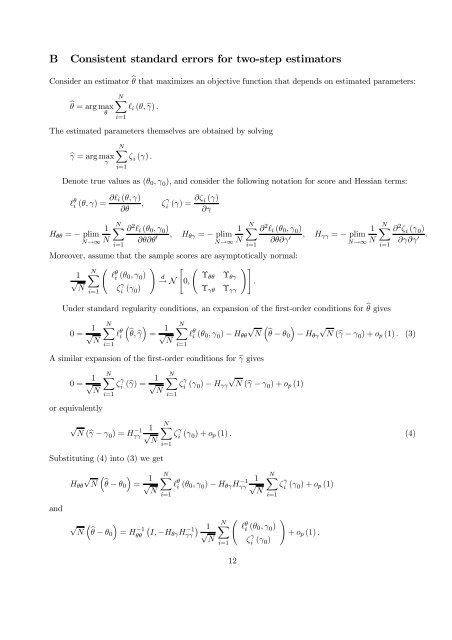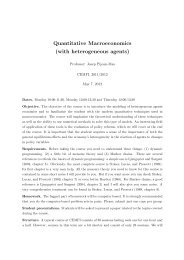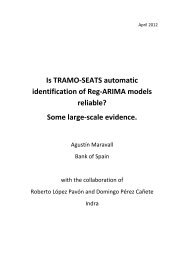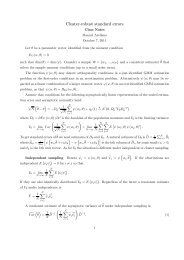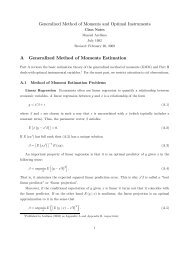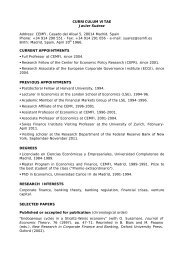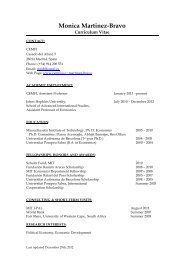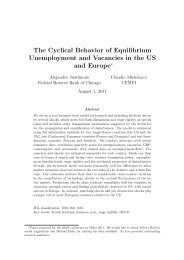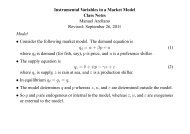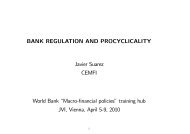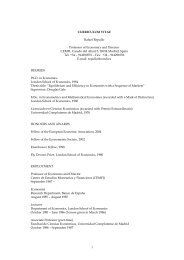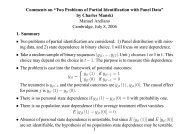Binary Models with Endogenous Explanatory Variables 1 ... - Cemfi
Binary Models with Endogenous Explanatory Variables 1 ... - Cemfi
Binary Models with Endogenous Explanatory Variables 1 ... - Cemfi
You also want an ePaper? Increase the reach of your titles
YUMPU automatically turns print PDFs into web optimized ePapers that Google loves.
B Consistent standard errors for two-step estimators<br />
Consider an estimator b θ that maximizes an objective function that depends on estimated parameters:<br />
b θ =argmax<br />
θ<br />
NX<br />
`i (θ, bγ) .<br />
i=1<br />
The estimated parameters themselves are obtained by solving<br />
bγ =argmax<br />
γ<br />
NX<br />
ζi (γ) .<br />
i=1<br />
Denote true values as (θ0, γ 0), and consider the following notation for score and Hessian terms:<br />
` θ i (θ, γ) = ∂`i (θ, γ)<br />
, ζ<br />
∂θ<br />
γ<br />
i (γ) =∂ζ i (γ)<br />
∂γ<br />
Hθθ = − plim<br />
N→∞<br />
1<br />
N<br />
NX<br />
i=1<br />
∂ 2 `i (θ0, γ 0)<br />
∂θ∂θ 0 , Hθγ = − plim<br />
N→∞<br />
Moreover, assume that the sample scores are asymptotically normal:<br />
NX<br />
Ã<br />
1 `θ i (θ0, γ<br />
√<br />
0)<br />
N ζ γ<br />
i (γ ! " Ã<br />
d Υθθ<br />
→ N 0,<br />
0)<br />
Υγθ<br />
Υθγ<br />
Υγγ<br />
!#<br />
.<br />
i=1<br />
1<br />
N<br />
NX<br />
i=1<br />
∂ 2 `i (θ0, γ 0)<br />
∂θ∂γ 0 , Hγγ = − plim<br />
N→∞<br />
Under standard regularity conditions, an expansion of the first-order conditions for b θ gives<br />
0= 1<br />
√ N<br />
NX<br />
i=1<br />
` θ i<br />
³ ´<br />
bθ, bγ = 1<br />
√<br />
N<br />
A similar expansion of the first-order conditions for bγ gives<br />
0= 1<br />
√ N<br />
or equivalently<br />
NX<br />
i=1<br />
ζ γ 1<br />
i (bγ) = √<br />
N<br />
√ N (bγ − γ0) =H −1<br />
γγ<br />
1<br />
√<br />
N<br />
Substituting (4) into (3) we get<br />
and<br />
√ ³ ´<br />
Hθθ N bθ − θ0 = 1<br />
√<br />
N<br />
√ ³ ´<br />
N bθ − θ0<br />
= H −1<br />
θθ<br />
NX<br />
i=1<br />
NX<br />
i=1<br />
NX<br />
i=1<br />
NX<br />
i=1<br />
1<br />
N<br />
NX<br />
i=1<br />
∂ 2 ζ i (γ 0)<br />
∂γ∂γ 0 .<br />
` θ √ ³ ´ √<br />
i (θ0, γ0) − Hθθ N bθ − θ0 − Hθγ N (bγ − γ0)+op (1) . (3)<br />
ζ γ<br />
i (γ √<br />
0) − Hγγ N (bγ − γ0)+op (1)<br />
ζ γ<br />
i (γ 0)+op (1) . (4)<br />
` θ i (θ0, γ 0) − HθγH −1<br />
γγ<br />
¡<br />
I,−HθγH −1¢<br />
1<br />
γγ √N<br />
i=1<br />
1<br />
√<br />
N<br />
NX<br />
i=1<br />
ζ γ<br />
i (γ 0)+op (1)<br />
NX<br />
Ã<br />
`θ i (θ0, γ0) ζ γ<br />
i (γ !<br />
+ op (1) .<br />
0)<br />
12


